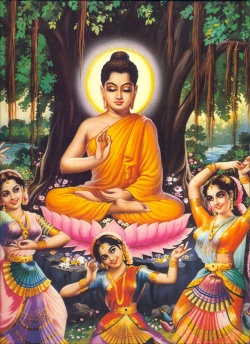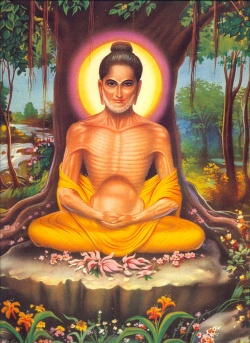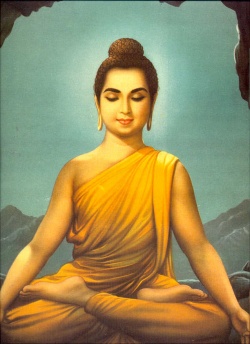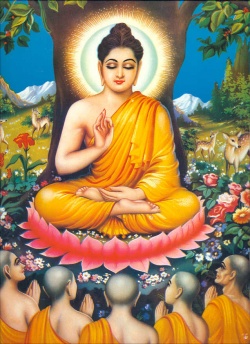Mahāmālunkya Sutta - The Greater Discourse to Mālunkyāputta
1. THUS HAVE I HEARD. On one occasion the Blessed One was living at Sāvatthī in Jeta’s Grove, Anāthapiṇḍika’s Park. There he addressed the bhikkhus thus: “Bhikkhus.”—“Venerable sir,” they replied. The Blessed One said this:
2. “Bhikkhus, do you remember the five lower fetters as taught by me?”
When this was said, the venerable Mālunkyāputta replied: “Venerable sir, I remember the five lower fetters as taught by the Blessed One.”649
“But, Mālunkyāputta, in what way do you remember the five lower fetters as taught by me?”
“Venerable sir, I remember identity view as a lower fetter taught by the Blessed One. I remember doubt as a lower fetter taught by the Blessed One. I remember adherence to rules and observances as a lower fetter taught by the Blessed One. I remember sensual desire as a lower fetter taught by the Blessed One. I remember ill will as a lower fetter taught by the Blessed One. It is in this way, venerable sir, that I remember the five lower fetters as taught by the Blessed One.”
3. “Mālunkyāputta, to whom do you remember my having taught these five lower fetters in that way?650 Would not the wanderers of other sects confute you with the simile of the infant? For a young tender infant lying prone does not even have the notion ‘identity,’ [433] so how could identity view arise in him? Yet the underlying tendency to identity view lies within him.651
A young tender infant lying prone does not even have the notion ‘teachings,’652 so how could doubt about the teachings arise in him? Yet the underlying tendency to doubt lies within him.
A young tender infant lying prone does not even have the notion ‘rules,’ so how could adherence to rules and observances arise in him? Yet the underlying tendency to adhere to rules and observances lies within him.
A young tender infant lying prone does not even have the notion ‘sensual pleasures,’ so how could sensual desire arise in him? Yet the underlying tendency to sensual lust lies within him.
A young tender infant lying prone does not even have the notion ‘beings,’ so how could ill will towards beings arise in him? Yet the underlying tendency to ill will lies within him. Would not the wanderers of other sects confute you with this simile of the infant?”
4. Thereupon, the venerable Ānanda said: “It is the time, Blessed One, it is the time, Sublime One, for the Blessed One to teach the five lower fetters. Having heard it from the Blessed One, the bhikkhus will remember it.”
“Then listen, Ānanda, and attend closely to what I shall say.”
“Yes, venerable sir,” the venerable Ānanda replied.
The Blessed One said this:
5. “Here, Ānanda, an untaught ordinary person who has no regard for noble ones and is unskilled and undisciplined in their Dhamma, who has no regard for true men and is unskilled and undisciplined in their Dhamma,
abides with a mind obsessed and enslaved by identity view, and he does not understand as it actually is the escape from the arisen identity view; and when that identity view has become habitual and is uneradicated in him,
it is a lower fetter. He abides with a mind obsessed and enslaved by doubt…by adherence to rules and observances …by sensual lust [434]…by ill will, and he does not understand as it actually is the escape from arisen ill will; and when that ill will has become habitual and is uneradicated in him, it is a lower fetter.
6. “A well-taught noble disciple who has regard for noble ones and is skilled and disciplined in their Dhamma, who has regard for true men and is skilled and disciplined in their Dhamma,
does not abide with a mind obsessed and enslaved by identity view; he understands as it actually is the escape from the arisen identity view,
and identity view together with the underlying tendency to it is abandoned in him.653 He does not abide with a mind obsessed and enslaved by doubt…by adherence to rules and observances…by sensual lust…by ill will; he understands as it actually is the escape from the arisen ill will, and ill will together with the underlying tendency to it is abandoned in him.
7. “There is a path, Ānanda, a way to the abandoning of the five lower fetters; that anyone, without relying on that path, on that way, shall know or see or abandon the five lower fetters—this is not possible.
Just as when there is a great tree standing possessed of heartwood, it is not possible that anyone shall cut out its heartwood without cutting through its bark and sapwood, so too, there is a path…this is not possible.
“There is a path, Ānanda, a way to the abandoning of the five lower fetters; [435] that someone, by relying on that path, on that way, shall know and see and abandon the five lower fetters—this is possible.
Just as, when there is a great tree standing possessed of heartwood, it is possible that someone shall cut out its heartwood by cutting through its bark and sapwood, so too, there is a path…this is possible.
8. “Suppose, Ānanda, the river Ganges were full of water right up to the brim so that crows could drink from it, and then a feeble man came thinking:
‘By swimming across the stream with my arms, I shall get safely across to the further shore of this river Ganges’; yet he would not be able to get safely across. So too, when the Dhamma is being taught to someone for the cessation of personality, if his mind does not enter into it and acquire confidence, steadiness, and resolution, then he can be regarded as like the feeble man.
“Suppose, Ānanda, the river Ganges were full of water right up to the brim so that crows could drink from it, and then a strong man came thinking: ‘By swimming across the stream with my arms, I shall get safely across to the further shore of this river Ganges’; and he would be able to get safely across. So too, when the Dhamma is being taught to someone for the cessation of personality, if his mind enters into it and acquires confidence, steadiness, and resolution, then he can be regarded as like the strong man.
9. “And what, Ānanda, is the path, the way to the abandoning of the five lower fetters? Here, with seclusion from the acquisitions, 654 with the abandoning of unwholesome states, with the complete tranquillization of bodily inertia, quite secluded from sensual pleasures, secluded from unwholesome states, a bhikkhu enters upon and abides in the first jhāna, which is accompanied by applied and sustained thought, with rapture and pleasure born of seclusion.
“Whatever exists therein of material form, feeling, perception, formations, and consciousness, he sees those states as impermanent, as suffering, as a disease, as a tumour, as a barb, as a calamity, as an affliction, as alien, as disintegrating, as void, as not self.655 He turns his mind away from those states [436] and directs it towards the deathless element thus: ‘This is the peaceful, this is the sublime, that is, the stilling of all formations, the relinquishing of all attachments, the destruction of craving, dispassion, cessation, Nibbāna.’656 If he is steady in that, he attains the destruction of the taints. But if he does not attain the destruction of the taints because of that desire for the Dhamma, that delight in the Dhamma,657 then with the destruction of the five lower fetters he becomes one due to reappear spontaneously [in the Pure Abodes) and there attain final Nibbāna without ever returning from that world. This is the path, the way to the abandoning of the five lower fetters.
10-12. “Again, with the stilling of applied and sustained thought, a bhikkhu enters upon and abides in the second jhāna…Again, with the fading away as well of rapture, a bhikkhu…enters upon and abides in the third jhāna…Again,a with the abandoning of pleasure and pain…a bhikkhu enters upon and abides in the fourth jhāna, which has neither-pain-nor-pleasure and purity of mindfulness due to equanimity.
“Whatever exists therein of material form, feeling, perception, formations, and consciousness, he sees those states as impermanent…as not self. He turns his mind away from those states and directs it towards the deathless element…This is the path, the way to the abandoning of the five lower fetters.
13. “Again, with the complete surmounting of perceptions of form, with the disappearance of perceptions of sensory impact, with non-attention to perceptions of diversity, aware that ‘space is infinite,’ a bhikkhu enters upon and abides in the base of infinite space.
“Whatever exists therein of feeling, perception, formations, and consciousness,658 he sees those states as impermanent…as not self. He turns his mind away from those states and directs it towards the deathless element…This is the path, the way to the abandoning of the five lower fetters.
14. “Again, by completely surmounting the base of infinite space, aware that ‘consciousness is infinite,’ a bhikkhu enters upon and abides in the base of infinite consciousness.
“Whatever exists therein of feeling, perception, formations, and consciousness, he sees those states as impermanent…as not self. He turns his mind away from those states and directs it towards the deathless element…This is the path, the way to the abandoning of the five lower fetters.
15. “Again, by completely surmounting the base of infinite consciousness, aware that ‘there is nothing,’ a bhikkhu enters upon and abides in the base of nothingness.
“Whatever exists therein of feeling, perception, formations, and consciousness, he sees those states as impermanent, as suffering, as a disease, as a tumour, as a barb, as a calamity, as an affliction, as alien, as disintegrating, as void, as not self. He turns his mind away from those states and directs it towards the deathless element thus: ‘This is the peaceful, this is the sublime, that is, the stilling of all formations, the relinquishing of all attachments, the destruction of craving, dispassion, cessation, Nibbāna.’ If he is steady in that, [437] he attains the destruction of the taints. But if he does not attain the destruction of the taints because of that desire for the Dhamma, that delight in the Dhamma, then with the destruction of the five lower fetters he becomes one due to reappear spontaneously [in the Pure Abodes) and there attain final Nibbāna without ever returning from that world. This is the path, the way to the abandoning of the five lower fetters.”
16. “Venerable sir, if this is the path, the way to the abandoning of the five lower fetters, then how is it that some bhikkhus here [are said to] gain deliverance of mind and some [are said to] gain deliverance by wisdom?”
“The difference here, Ānanda, is in their faculties, I say.”659
That is what the Blessed One said. The venerable Ānanda was satisfied and delighted in the Blessed One’s words.
649 The five lower fetters (orambhāgiyāni saṁyojanāni) are so called because they lead to rebirth in the sense-sphere planes. They are eradicated in their entirety only by the non-returner.
650 MA: The question may be raised: “When the Buddha had asked about the fetters and the Elder replied in terms of the fetters, why does the Buddha criticise his reply?” The reason is that Mālunkyāputta held the view that a person is fettered by the defilements only at times when they assail him, while at other times he is not fettered by them. The Buddha spoke as he did to show the error in this view.
651 Anuseti tvev’assa sakkāyadiṭṭ̣hānusayo. On the anusayas or underlying tendencies, see n.473. In the commentaries the defilements are distinguished as occurring at three levels: the anusaya level, where they remain as mere latent dispositions in the mind; the pariyuṭṭ̣hāna level, where they rise up to obsess and enslave the mind (referred to in §5 of this discourse); and the vı̄tikkama level, where they motivate unwholesome bodily and verbal action. The point of the Buddha’s criticism is that the fetters, even when they do not come to active manifestation, continue to exist at the anusaya level so long as they have not been eradicated by the supramundane path.
652 Dhammā. This could also have been rendered “things.”
653 MA: The fetter and the underlying tendency are in principle not distinct things; rather, it is the same defilement that is called a fetter in the sense of binding, and an underlying tendency in the sense of being unabandoned.
654 Upadhivivekā. MA glosses upadhi here as the five cords of sensual pleasure. Though the first three clauses of this statement seem to express the same ideas as the two more usual clauses that follow, Ṃ indicates that they are intended to show the means for becoming “quite secluded from sensual pleasures, secluded from unwholesome states.”
655 This passage shows the development of insight (vipassanā) upon a basis of serenity (samatha), using the jhāna on which the practice of insight is based as the object of insight contemplation. See MN 52.4 and n.552. Here two terms—impermanent and disintegrating—show the characteristic of impermanence; three terms—alien, void, and not self—show the characteristic of non-self; the remaining six terms show the characteristic of suffering.
656 MA: He “turns his mind away” from the five aggregates included within the jh̄na, which he has seen to be stamped with the three characteristics. The “deathless element” (amatā dhātu) is Nibbāna. First “he directs his mind to it” with the insight consciousness, having heard it praised and described as “the peaceful and sublime,” etc. Then, with the supramundane path, “he directs his mind to it” by making it an object and penetrating it as the peaceful and sublime, etc.
657 See n.553.
658 On the omission of the fourth immaterial attainment, see n.554.
659 MA: Among those who proceed by way of serenity, one bhikkhu emphasises unification of mind—he is said to gain deliverance of mind; another emphasises wisdom—he is said to gain deliverance by wisdom. Among those who proceed by way of insight, one emphasises wisdom—he is said to gain deliverance by wisdom; another emphasises unification of mind—he is said to gain deliverance of mind. The two chief disciples attained arahantship by emphasising both serenity and insight, but Ven. Sāriputta became one who gained deliverance by wisdom and Ven. Mahā Moggallāna became one who gained deliverance of mind. Thus the reason (for the different designations) is the difference in their faculties, i.e., between the predominance of the concentration faculty and of the wisdom faculty.








